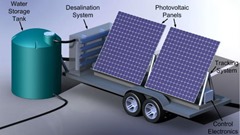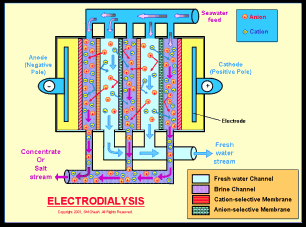 By inexpensively turning salt water into drinking water using sustainable solar power, a team from MIT in the US has not only come up with a portable desalination system for use anywhere in the world that needs it, but it’s just won the 2015 Desal Prize – a competition run by USAID to encourage better solutions to water shortages in developing countries.
By inexpensively turning salt water into drinking water using sustainable solar power, a team from MIT in the US has not only come up with a portable desalination system for use anywhere in the world that needs it, but it’s just won the 2015 Desal Prize – a competition run by USAID to encourage better solutions to water shortages in developing countries.
In order to win the $140,000 prize, entries had to demonstrate how their invention not only works well, but is cost-effective, environmentally sustainable, and energy efficient. And the MIT researchers teamed up with US-based manufacturing company, Jain Irrigation Systems, to do just that.
The team’s invention works by using solar panels to charge a cache of batteries that power an electrodialysis machine that removes salt from the water and makes it perfectly drinkable. David L. Chandler explains for MIT News:
“Electrodialysis works by passing a stream of water between two electrodes with opposite charges. Because the salt dissolved in water consists of positive and negative ions, the electrodes pull the ions out of the water, Winter says, leaving fresher water at the centre of the flow. A series of membranes separate the freshwater stream from increasingly salty ones.”
Solar-powered desalination plants are nothing new, and officials are investigating potential in water-poor areas such as Chile and California right now, but the technology has so far been extremely expensive to both piece together and run. And this obviously makes it difficult for developing countries to adopt. The key to the MIT plant is the electrodialysis process, says Chandler, talking to one of the team, mechanical engineer Amos Winter:
“Both electrodialysis and reverse osmosis require the use of membranes, but those in an electrodialysis system are exposed to lower pressures and can be cleared of salt buildup simply by reversing the electrical polarity. That means the expensive membranes should last much longer and require less maintenance, Winter says.”
Chandler reports that the MIT system can turn 90% of the salt water that’s fed into it into drinking water, which is huge, compared to the 40-60% from reverse-osmosis systems.
 The team has been testing their system out in several villages across India since 2014, and have been using the Brackish Groundwater National Desalination Research Facility in the US to run 24-hour tests to analyse its efficiency and cost of maintenance. According to Mary Beth Griggs at Popular Science, in just 24 hours, their system can remove the salt from 2,100 gallons (7,950 litres).
The team has been testing their system out in several villages across India since 2014, and have been using the Brackish Groundwater National Desalination Research Facility in the US to run 24-hour tests to analyse its efficiency and cost of maintenance. According to Mary Beth Griggs at Popular Science, in just 24 hours, their system can remove the salt from 2,100 gallons (7,950 litres).
They’re now hoping to expand their field tests to rural communities in developing countries, in the hopes that they can set them up as irrigation systems in small farms. “A solution with the potential to double recoverable water in an environment where water is becoming more precious by the day could have a huge impact,” environmental and civil engineer Susan Amrose from the University of California at Berkeley, told MIT News.
Science Alert BEC Crew 27 April 2015 | See also: ![]()
